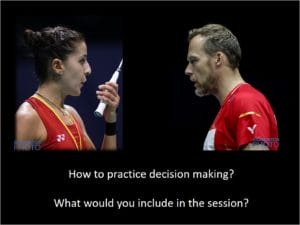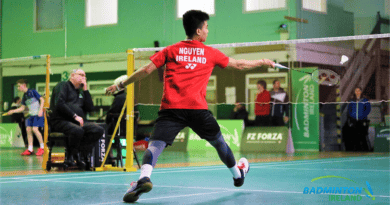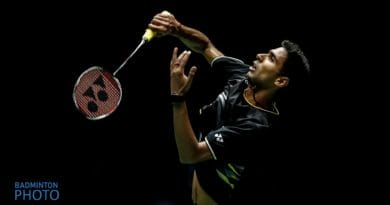Badminton Footwork Part 4 : footwork in the high forehand rearcourt
When I started coaching the footwork and hitting actions in this court, I was confused
Especially in relation to shuttles high in the wide forehand court
– which technique was best, which to introduce first
All the coaching manuals at that time stated that overhead forehands (clear /drop/smash) would be played with a full rotation of the body. This was specifically to encourage a throwing action and forward recovery badminton footwork.
Then later I was introduced to other techniques that had been right in front of my eyes but I’d never coached them
In this video, Thomas Laybourn from Badminton Family.com excellently demonstrates a full body turn (rotation) and recovery back to the centre of the court. It’s a great detailed explanation 🙂
Before we look at the detail, have you ever considered which court you would use to first introduce the overhead forehand?
I mean, do you favour starting with players in the FH or RTH courts. I’ve found that there is a big difference, especially if you want a ‘throwing action’.
Click on this image to read more
– – – – – – – – – – – – – – – – – –
Previous linked posts
Choices for Movement and hitting
The ‘critical’ and essential components
Recommendations
– – – – – – – – – – – – – – – –
This post is Part 4 and the last of the mini-series
… click here to read Part 1 which looks at the FH net and recovery
… click here to read Part 2 which looks at an alternative “starting stance” for the backhand net
.. click here to read Part 3 which looks at the recovery from the Round The Head court
When I met my coaching mentor, he opened my eyes to at least 3 or 4 different ways to move and play strokes in the forehand rearcourt
All have a Tactical reason (a player choice)
I thought I knew what to coach. It seemed to depend on the position of the shuttle, was it high and wide, deep and low, just above head height and moving quickly. But again, I was wrong!
Then I realised it also depended on the tactical part of the rally.
Does the player want to try and play a quick intercept, how much energy do they want to use, could they play a ‘safer’ stroke if they waited a little.
All these questions revolved around a decision, a choice…. TACTICS!
Thomas is showing a full rotation in the video. So, we must presume that the lift is high enough and the player fast enough to choose to move to this area and hit with a full body rotation. However, it’s also ok to play a shuttle from this same height with no rotation and to stay side on throughout the hitting action.
In later posts, I intend to write more about the ‘sideways’ striking options and why it’s equally effective and often the preferred choice for players. Keep an open mind as when it comes to Badminton footwork, there are always differing opinions.
– – – – – – – – – – – – – – – –
Choices for Movement and hitting
For shuttles that are High and Wide in the Forehand court there are two movement/hitting actions :
1 Full rotation with a push up of the court
2 Sideways hitting action with no rotation

Players
If you are a young player and been playing less than 3 years, what movements in this high forehand court have you been using?
Do you always try to get there ‘early’? Have you been encouraged (told) to use a certain technique?
Coaches
Which badminton movement technique would you introduce first to a player?
Are there certain key aspects that you want to encourage and instil before others. Often the key elements apply to both techniques. But, which technique encourages the development of each?
Which of the 2 hitting techniques allows for an easier development of these? Then most importantly, what practice situations do you set up to create an effective session.
– – – – – – – – – – – – – – – –
The ‘critical’ and essential components
- ‘throwing actions for power’
- powerful rear leg ‘push up’ off the court
- wide base on landing
- fast forwards recovery
- early preparations for intercepts and deceptions
Q) what do you have on your list?
– – – – – – – – – – – – – – – –
Recommendations
I recommend that the initial coaching and practices should follow this list.
However, of course, it depends on the player and their current specific standard in this part of the court.
- start with deep forehands (drags/pulls) with a quick wide feed and Early Preparation
- start the practice with a player ‘block feed’, reduce the amount of single-shot / multi coach feeding
- vary the height of the lifts – use high feeds to encourage overhead rotations
- set up situations that allow for player anticipation/perception/actions/choices – less multi
- introduce and allow for powerful ‘step up and out’ movements
- encourage chasse and powerful jump ups/outs (with and without rotation)
It’s very important to create practice situations that allow the player to choose one of these 4 movements, detailed above 😉 the feed and the players ‘ perception/action’ is key in deciding which movement is used. It’s not the Coach shouting what to do !
In all practices, I recommend using 1 shuttle, and that shuttle should be returned by an opponent/feeder.
Doing this will highlight the advantages and disadvantages of each of the 4 main movements / hitting actions.
The key practice element
It is key that the player decides which of the 4 badminton footwork movements to choose
Practice each type of footwork specifically but ensure that as soon as possible, the variations are introduced. Variations that allow the player to decide which one to use.
It is possible to practice by using a stationary feeder holding x15 shuttles, but be aware that you are missing out on much more information
Consider the tactical intent and ALWAYS have the same shuttle returned

– – – – – – – – – – – – – – – –
Can you help me?
As always I would love to read your comments and thoughts. This post has been tough to write as there are many coaches and players out there with theories on how to play and what technique to use and may I upset someone. Badminton footwork creates so many different opinions, mine is just one.
So your feedback is essential to me. My aim is to provide guidelines that can be challenged.
I believe that it’s the PRACTICE situations that you use that will influence how you develop
Stay true to Game-like Situations & Conditions then hopefully you will develop Game-like responses
Become a Player, not a Trainer





